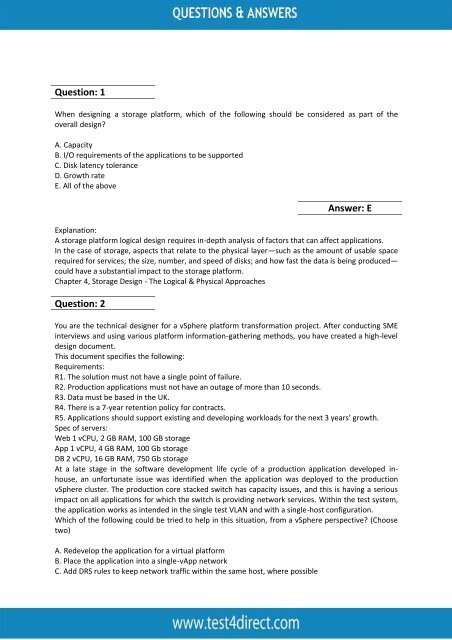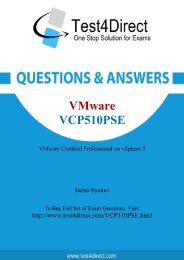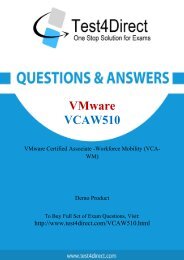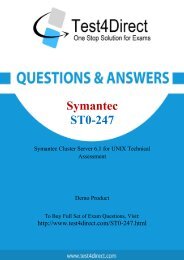Buy VCAP5-DCD BrainDumps and Get Discount
Test4Direct provides latest PDF questions of VMware VCAP5-DCD exam. You have an opportunity to pass the VMware VCAP5-DCD exam in one go. Test4Direct is most accurate source to prepare VMware VCAP5-DCD exam as your success will become site’s responsibility after purchasing VCAP5-DCD exam product. There are also lots of discounts and promotion offers that you can avail. Let’s try a free demo http://www.test4direct.com/VCAP5-DCD.html
Test4Direct provides latest PDF questions of VMware VCAP5-DCD exam. You have an opportunity to pass the VMware VCAP5-DCD exam in one go. Test4Direct is most accurate source to prepare VMware VCAP5-DCD exam as your success will become site’s responsibility after purchasing VCAP5-DCD exam product. There are also lots of discounts and promotion offers that you can avail. Let’s try a free demo http://www.test4direct.com/VCAP5-DCD.html
Create successful ePaper yourself
Turn your PDF publications into a flip-book with our unique Google optimized e-Paper software.
Question: 1<br />
When designing a storage platform, which of the following should be considered as part of the<br />
overall design?<br />
A. Capacity<br />
B. I/O requirements of the applications to be supported<br />
C. Disk latency tolerance<br />
D. Growth rate<br />
E. All of the above<br />
Question: 2<br />
Answer: E<br />
Explanation:<br />
A storage platform logical design requires in-depth analysis of factors that can affect applications.<br />
In the case of storage, aspects that relate to the physical layer—such as the amount of usable space<br />
required for services; the size, number, <strong>and</strong> speed of disks; <strong>and</strong> how fast the data is being produced—<br />
could have a substantial impact to the storage platform.<br />
Chapter 4, Storage Design - The Logical & Physical Approaches<br />
You are the technical designer for a vSphere platform transformation project. After conducting SME<br />
interviews <strong>and</strong> using various platform information-gathering methods, you have created a high-level<br />
design document.<br />
This document specifies the following:<br />
Requirements:<br />
R1. The solution must not have a single point of failure.<br />
R2. Production applications must not have an outage of more than 10 seconds.<br />
R3. Data must be based in the UK.<br />
R4. There is a 7-year retention policy for contracts.<br />
R5. Applications should support existing <strong>and</strong> developing workloads for the next 3 years’ growth.<br />
Spec of servers:<br />
Web 1 vCPU, 2 GB RAM, 100 GB storage<br />
App 1 vCPU, 4 GB RAM, 100 Gb storage<br />
DB 2 vCPU, 16 GB RAM, 750 Gb storage<br />
At a late stage in the software development life cycle of a production application developed inhouse,<br />
an unfortunate issue was identified when the application was deployed to the production<br />
vSphere cluster. The production core stacked switch has capacity issues, <strong>and</strong> this is having a serious<br />
impact on all applications for which the switch is providing network services. Within the test system,<br />
the application works as intended in the single test VLAN <strong>and</strong> with a single-host configuration.<br />
Which of the following could be tried to help in this situation, from a vSphere perspective? (Choose<br />
two)<br />
A. Redevelop the application for a virtual platform<br />
B. Place the application into a single-vApp network<br />
C. Add DRS rules to keep network traffic within the same host, where possible
















